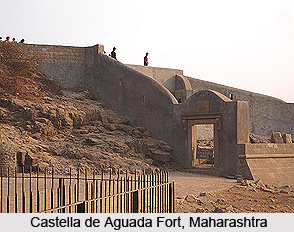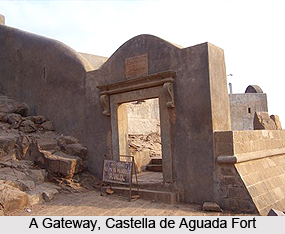 Castella de Aguada is also referred to as the `Bandra Fort` and is situated at Land`s End in the region of Bandra in Mumbai city in the state of Maharashtra, being constructed during 1640 by the Portuguese as a watchtower. It is known as `Forte de Bandora` as per the Portuguese language which implies the `Bandra Fort`. It is surrounded by the southern island of Mahim, Arabian Sea and Mahim Bay. In the year 1661, Castella de Aguada Fort`s significance was enhanced after the seven islands of Mumbai were surrendered to the British by the Portuguese and they were based to the south of the Bandra Fort. The nomenclature of this fort has been derived from the place which contains fresh water in the form of a `fountain` or `Aguada`, wherein the Portuguese ships cruised alongside the regional coasts. Castella de Aguada is present at an elevation of nearly 24 metres from mean sea level and has been displayed in some Bollywood or Hindi movies including `Buddha Mil Gaya` and `Dil Chahta Hai`. The Archaeological Survey of India or ASI is responsible for the preservation of this Indian fort.
Castella de Aguada is also referred to as the `Bandra Fort` and is situated at Land`s End in the region of Bandra in Mumbai city in the state of Maharashtra, being constructed during 1640 by the Portuguese as a watchtower. It is known as `Forte de Bandora` as per the Portuguese language which implies the `Bandra Fort`. It is surrounded by the southern island of Mahim, Arabian Sea and Mahim Bay. In the year 1661, Castella de Aguada Fort`s significance was enhanced after the seven islands of Mumbai were surrendered to the British by the Portuguese and they were based to the south of the Bandra Fort. The nomenclature of this fort has been derived from the place which contains fresh water in the form of a `fountain` or `Aguada`, wherein the Portuguese ships cruised alongside the regional coasts. Castella de Aguada is present at an elevation of nearly 24 metres from mean sea level and has been displayed in some Bollywood or Hindi movies including `Buddha Mil Gaya` and `Dil Chahta Hai`. The Archaeological Survey of India or ASI is responsible for the preservation of this Indian fort.
History of Castella de Aguada Fort
Following the defeat of Gujarat`s ruler, Bahadur Shah, the Portuguese established numerous sea forts close to the coastal regions of the country and occupied the region in 1634.
 The fort was built in a strategic location which protected the northern sea route into Mumbai Harbour which was once a giant estuary. During the reign of the Portuguese, the Bandra Fort was well equipped with war equipments and seven cannons, apart from small guns. Water was made available to the residents of this fort in the form of a freshwater spring which was located near the fort which provided water to passing ships.
The fort was built in a strategic location which protected the northern sea route into Mumbai Harbour which was once a giant estuary. During the reign of the Portuguese, the Bandra Fort was well equipped with war equipments and seven cannons, apart from small guns. Water was made available to the residents of this fort in the form of a freshwater spring which was located near the fort which provided water to passing ships.
However, the British dominions and belongings were thwarted by the Marathas soon after the downfall of the Portuguese in the initial phase of the 18th century. Having realized their imminent defeat in the hands of the Marathas, the British destroyed the fort partly as a preventive measure, against the Maratha invasion. This would eliminate the probability of the Castella de Aguada Fort being conquered by the Marathas who would have then employed it as a military base to launch fresh attacks on British Mumbai.
The Marathas captured this island in the year 1739 and controlled this part of the nation till 1774 when it slipped into British hands after the First Anglo Maratha War. Large portions of Salsette Island as well as Land`s End were then donated by the British in 1830 to Byramjee Jeejeebhoy who was a Parsi benefactor. Thereafter, the cape was renamed `Byramjee Jeejeebhoy Point` and he made his own residence on the summit of the hill.
Conservation of Castella de Aguada Fort
Bandra Band Stand Residents` Trust commenced a conservation event in 2003 aimed at restoring the fort to its previous grace and it was done under the leadership of Shabana Azmi, Indian movie actress and local Member of Parliament or MP. It was discovered that the brick arch of a gateway of the fort was on the blink of immediate collapse and the foundations of the walls of the fort would soon undergo tidal erosion. Therefore these parts were soon repaired. The pathways and natural rock creations which imparted the appearance of an amphitheatre to the fort was preserved under the supervision of P.K. Das, an architect.



















